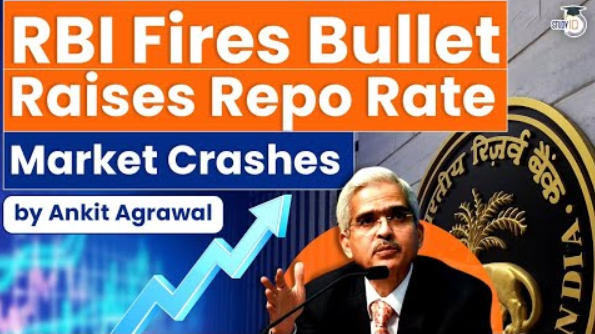Table of Contents
What has happened?
- Interest rates in the banking system are set to go up after the Reserve Bank of India (RBI) on Wednesday (May 4) jacked up the Repo rate, the main policy rate, by 40 basis points to 4.40% and
- The cash reserve ratio (CRR) by 50 basis points to 4.50% to suck out liquidity and bring down the elevated inflation.
- However, the central bank retained the accommodative monetary policy in an unscheduled meeting of the Monetary Policy Committee (MPC) on Wednesday.
What RBI said?
- RBI Governor Shaktikanta Das announced that the Monetary Policy Committee (MPC) had met over the previous two days and unanimously decided toraise the benchmark interest rate in the economy.
- The RBI has argued that it is concerned about the rising level of inflation.
- By raising the repo rate, the RBI hopes to incentivise people to spend less and save more, thus cooling down demand in the economy and, by extension, prices.
- The move — to have such a meeting and to raise the interest rates — is, at two different levels, both surprising and obvious.
- It is surprising because the RBI’s MPC meets once every two months — and the meeting this week was not scheduled.
- The MPC had met in February and April, and was set to meet next in June.

- The reasons for high inflation have tended to change over the months but overall, inflation has remained high.
- Sometimes it has been fuelled by high crude oil prices as well as the high level of taxation on such fuels — as indeed is happening now — and sometimes it has been kicked up by the scarcity of food articles, perhaps because of unseasonal rains.
- And yet, for the most part since October 2019, the RBI has very openly given first preference to boosting growth — by keeping interest rates low — instead of controlling inflation.
Impact of the move
- Equated monthly instalments (EMIs) on home, vehicle and other personal and corporate loans are likely to go up.
- Deposit rates are also set to rise after the Repo rate hike that came after nearly four years.
- By hiking the Repo rate and CRR, the RBI is aiming to keep inflation – which is already close to 7 per cent — at its desired level, and control and monitor money flow into the banking system at a time when the global economy is facing turbulent times.
Significance
- The hike in Repo rate – the key policy rate of RBI or the rate at which it lends to banks – means the cost of funds for banks will go up.
- This will prompt banks and NBFCs to raise the lending and deposit rates in the coming days.
- However, analysts say that consumption and demand can be impacted by the Repo rate hike.
- The RBI last hiked the Repo rate by 25 bps to 50 per cent in August 2018.
- SBI and many banks recently raised the MCLR (marginal cost of funds-based lending rate) points anticipating a rate hike.
- “It is necessary for monetary policy to focus on the withdrawal of accommodation,” RBI Governor Shaktikanta Das said on Wednesday.
Impact of the CRR hike
- CRR is the percentage of depositors’ money that commercial banks have to mandatorily park with the Reserve Bank.
- The 50 bps hike in CRR will suck out Rs 87,000 crore from the banking system.
- The lendable resources of banks will come down accordingly.
- It also means the cost of funds will go up and banks’ net interest margins could get adversely impacted.


Q) What is the primary objective of DICGC?
- Protect the interest of small depositors
- Protect the bank to fail
- Protect the large corporate from going bankrupt
- All of the above
Latest Burning Issues | Free PDF























 WhatsApp
WhatsApp